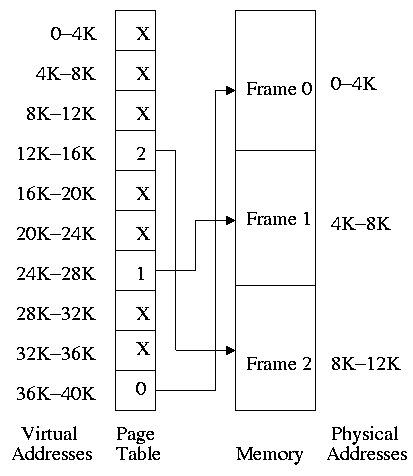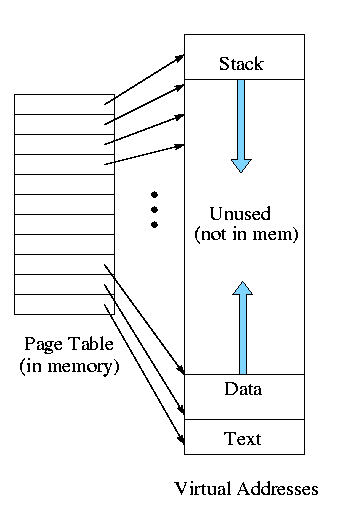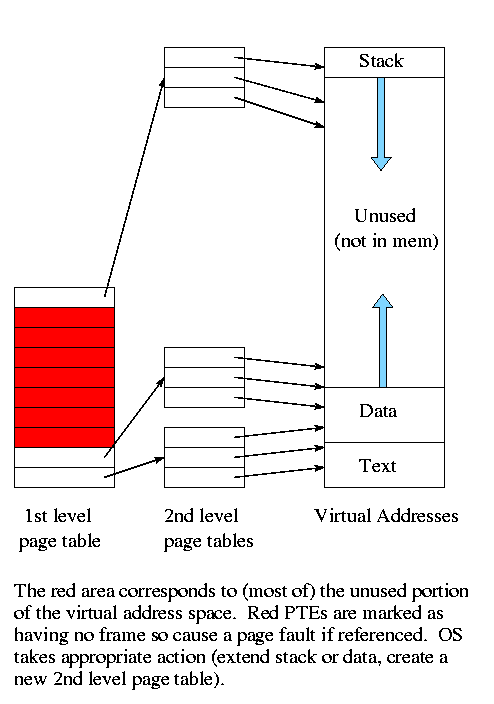================ Start Lecture #18
================
Address translation
- Each memory reference turns into 2 memory references
- Reference the page table
- Reference central memory
- This would be a disaster!
- Hence the MMU caches page#-->frame# translations. This cache is kept
near the processor and can be accessed rapidly.
- This cache is called a translation lookaside buffer (TLB) or
translation buffer (TB).
- For the above example, after referencing virtual address 3372,
there would be an entry in the TLB containing the mapping
3-->459.
- Hence a subsequent access to virtual address 3881 would be
translated to physical address 459881 without a memory reference.
Choice of page size is discuss below.
Homework: 8.
4.3: Virtual Memory (meaning fetch on demand)
Idea is that a program can execute even if only the active portion of its
address space is memory resident. That is, swap in and swap out
portions of a program. In a crude sense this can be called
``automatic overlays''.
Advantages
- Can run a program larger than the total physical memory.
- Can increase the multiprogramming level since the total size of
the active, i.e. loaded, programs (running + ready + blocked) can
exceed the size of the physical memory.
- Since some portions of a program are rarely if ever used, it is
an inefficient use of memory to have them loaded all the time. Fetch on
demand will not load them if not used and will unload them during
replacement if they are not used for a long time (hopefully).

4.3.1: Paging (meaning demand paging)
Fetch pages from disk to memory when they are referenced, with a hope
of getting the most actively used pages in memory.
- Very common: dominates modern operating systems.
- Started by the Atlas system at Manchester University in the 60s
(Fortheringham).
- Each PTE continues to have the frame number if the page is
loaded.
- But what if the page is not loaded (exists only on disk)?
- The PTE has a flag indicating if it is loaded (can think of
the X in the diagram on the right as indicating that this flag is
not set).
- If not loaded, the location on disk could be kept in the PTE
(not shown in the diagram). But normally it is not
(discussed below).
- When a reference is made to a non-loaded page (sometimes
called a non-existent page, but that is a bad name), the system
has a lot of work to do. We give more details
below.
- Choose a free frame, if one exists.
- If not
- Choose a victim frame.
- More later on how to choose a victim.
- Called the replacement question
- Write victim back to disk if dirty,
- Update the victim PTE to show that it is not loaded
and, perhaps, where on disk it has been put.
- Copy the referenced page from disk to the free frame.
- Update the PTE of the referenced page to show that it is
loaded and give the frame number.
- Do the standard paging address translation (p#,off)-->(f#,off).
- Really not done quite this way
- There is ``always'' a free frame because ...
- There is a deamon active that checks the number of free frames
and if this is too low, chooses victims and ``pages them out''
(writing them back to disk if dirty).
- Choice of page size is discussed below.
Homework: 12.
4.3.2: Page tables
A discussion of page tables is also appropriate for (non-demand)
paging, but the issues are more acute with demand paging since the
tables can be much larger. Why?
- The total size of the active processes is no longer limited to
the size of physical memory. Since the total size of the processes is
greater, the total size of the page tables is greater and hence
concerns over the size of the page table are more acute.
- With demand paging an important question is the choice of a victim
page to page out. Data in the page table
can be useful in this choice.
We must be able access to the page table very quickly since it is
needed for every memory access.
Unfortunate laws of hardware.
- Big and fast are essentially incompatible.
- Big and fast and low cost is hopeless.
So we can't just say, put the page table in fast processor registers,
and let it be huge, and sell the system for $1500.

For now, put the (one-level) page table in main memory.
- Seems too slow since all memory references require two reference.
- TLB very helpful to reduce the average delay as mentioned above
(discussed later in more detail).
- The page table might be too big.
- Currently we are considering contiguous virtual
addresses ranges (i.e. the virtual addresses have no holes).
- Typically put the stack at one end of virtual address and the
global (or static) data at the other end and let them grow towards
each other.
- The memory in between is unused.
- This unused memory can be huge (in address range) and hence
the page table will mostly contain unneeded PTEs.
- Works fine if the maximum virtual address size is small, which
was once true (e.g., the PDP-11 of the 1970s) but is no longer the
case.
Contents of a PTE
Each page has a corresponding page table entry (PTE). The
information in a PTE is for use by the hardware. Information set by
and used by the OS is normally kept in other OS tables. The page
table format is determined by the hardware so access routines are not
portable. The following fields are often present.
- The valid bit. This tells if
the page is currently loaded (i.e., is in a frame). If set, the frame
pointer is valid. It is also called the presence or
presence/absence bit. If a page is accessed with the valid
bit zero, a page fault is generated by the hardware.
- The frame number. This is the main reason for the table. It is
needed for virtual to physical address translation.
- The Modified bit. Indicates that some part of the page
has been written since it was loaded. This is needed when the page is
evicted so the OS can know that the page must be written back to disk.
- The referenced bit. Indicates that some word in the page
has been referenced. Used to select a victim: unreferenced pages make
good victims by the locality property (discussed below).
- Protection bits. For example one can mark text pages as
execute only. This requires that boundaries between regions with
different protection are on page boundaries. Normally many
consecutive (in logical address) pages have the same protection so
many page protection bits are redundant.
Protection is more
naturally done with segmentation.
Multilevel page tables (Not on 202 final exam)
Recall the previous diagram. Most of the virtual memory is the
unused space between the data and stack regions. However, with demand
paging this space does not waste real memory. But the single
large page table does waste real memory.

The idea of multi-level page tables (a similar idea is used in Unix
inode-based file systems) is to add a level of indirection and have a
page table containing pointers to page tables.
- Imagine one big page table.
- Call it the second level page table and
cut it into pieces each the size of a page.
Note that you can get many PTEs in one page so you will have far
fewer of these pages than PTEs
- Now construct a first level page table containing PTEs that point to
these pages.
- This first level PT is small enough to store in memory.
- But since we still have the 2nd level PT, we have made the world
bigger not smaller!
- Don't store in memory those 2nd level page tables all of whose PTEs
refer to unused memory. That is use demand paging on the (second
level) page table
Do an example on the board
The VAX used a 2-level page table structure, but with some wrinkles
(see Tanenbaum for details).
Naturally, there is no need to stop at 2 levels. In fact the SPARC
has 3 levels and the Motorola 68030 has 4 (and the number of bits of
Virtual Address used for P#1, P#2, P#3, and P#4 can be varied).



